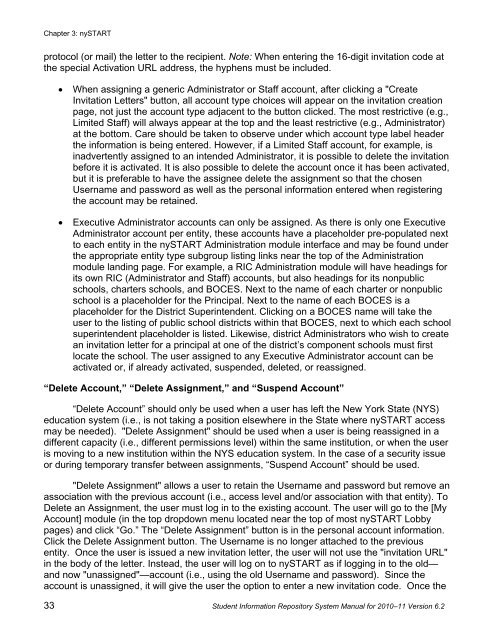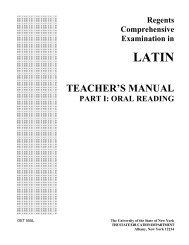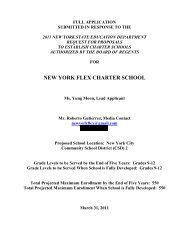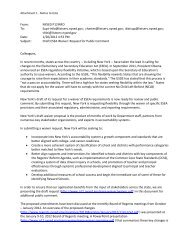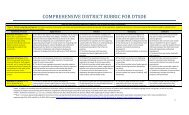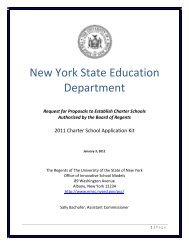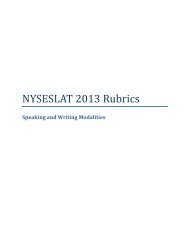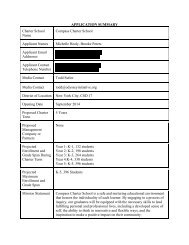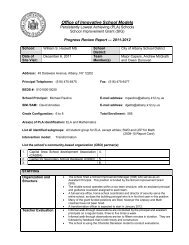SIRS - p-12 - New York State Education Department
SIRS - p-12 - New York State Education Department
SIRS - p-12 - New York State Education Department
Create successful ePaper yourself
Turn your PDF publications into a flip-book with our unique Google optimized e-Paper software.
Chapter 3: nySTART<br />
protocol (or mail) the letter to the recipient. Note: When entering the 16-digit invitation code at<br />
the special Activation URL address, the hyphens must be included.<br />
• When assigning a generic Administrator or Staff account, after clicking a "Create<br />
Invitation Letters" button, all account type choices will appear on the invitation creation<br />
page, not just the account type adjacent to the button clicked. The most restrictive (e.g.,<br />
Limited Staff) will always appear at the top and the least restrictive (e.g., Administrator)<br />
at the bottom. Care should be taken to observe under which account type label header<br />
the information is being entered. However, if a Limited Staff account, for example, is<br />
inadvertently assigned to an intended Administrator, it is possible to delete the invitation<br />
before it is activated. It is also possible to delete the account once it has been activated,<br />
but it is preferable to have the assignee delete the assignment so that the chosen<br />
Username and password as well as the personal information entered when registering<br />
the account may be retained.<br />
• Executive Administrator accounts can only be assigned. As there is only one Executive<br />
Administrator account per entity, these accounts have a placeholder pre-populated next<br />
to each entity in the nySTART Administration module interface and may be found under<br />
the appropriate entity type subgroup listing links near the top of the Administration<br />
module landing page. For example, a RIC Administration module will have headings for<br />
its own RIC (Administrator and Staff) accounts, but also headings for its nonpublic<br />
schools, charters schools, and BOCES. Next to the name of each charter or nonpublic<br />
school is a placeholder for the Principal. Next to the name of each BOCES is a<br />
placeholder for the District Superintendent. Clicking on a BOCES name will take the<br />
user to the listing of public school districts within that BOCES, next to which each school<br />
superintendent placeholder is listed. Likewise, district Administrators who wish to create<br />
an invitation letter for a principal at one of the district’s component schools must first<br />
locate the school. The user assigned to any Executive Administrator account can be<br />
activated or, if already activated, suspended, deleted, or reassigned.<br />
“Delete Account,” “Delete Assignment,” and “Suspend Account”<br />
“Delete Account” should only be used when a user has left the <strong>New</strong> <strong>York</strong> <strong>State</strong> (NYS)<br />
education system (i.e., is not taking a position elsewhere in the <strong>State</strong> where nySTART access<br />
may be needed). "Delete Assignment" should be used when a user is being reassigned in a<br />
different capacity (i.e., different permissions level) within the same institution, or when the user<br />
is moving to a new institution within the NYS education system. In the case of a security issue<br />
or during temporary transfer between assignments, “Suspend Account” should be used.<br />
"Delete Assignment" allows a user to retain the Username and password but remove an<br />
association with the previous account (i.e., access level and/or association with that entity). To<br />
Delete an Assignment, the user must log in to the existing account. The user will go to the [My<br />
Account] module (in the top dropdown menu located near the top of most nySTART Lobby<br />
pages) and click “Go.” The “Delete Assignment” button is in the personal account information.<br />
Click the Delete Assignment button. The Username is no longer attached to the previous<br />
entity. Once the user is issued a new invitation letter, the user will not use the "invitation URL"<br />
in the body of the letter. Instead, the user will log on to nySTART as if logging in to the old—<br />
and now "unassigned"—account (i.e., using the old Username and password). Since the<br />
account is unassigned, it will give the user the option to enter a new invitation code. Once the<br />
33 Student Information Repository System Manual for 2010–11 Version 6.2


